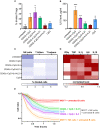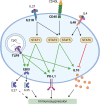Differentially activated B cells develop regulatory phenotype and show varying immunosuppressive features: a comparative study
- PMID: 37731503
- PMCID: PMC10509016
- DOI: 10.3389/fimmu.2023.1178445
Differentially activated B cells develop regulatory phenotype and show varying immunosuppressive features: a comparative study
Abstract
Regulatory B lymphocytes (Bregs) are B cells with well-pronounced immunosuppressive properties, allowing them to suppress the activity of effector cells. A broad repertoire of immunosuppressive mechanisms makes Bregs an attractive tool for adoptive cell therapy for diseases associated with excessive activation of immune reactions. Such therapy implies Breg extraction from the patient's peripheral blood, ex vivo activation and expansion, and further infusion into the patient. At the same time, the utility of Bregs for therapeutic approaches is limited by their small numbers and extremely low survival rate, which is typical for all primary B cell cultures. Therefore, extracting CD19+ cells from the patient's peripheral blood and specifically activating them ex vivo to make B cells acquire a suppressive phenotype seems to be far more productive. It will allow a much larger number of B cells to be obtained initially, which may significantly increase the likelihood of successful immunosuppression after adoptive Breg transfer. This comparative study focuses on finding ways to efficiently manipulate B cells in vitro to differentiate them into Bregs. We used CD40L, CpG, IL4, IL21, PMA, and ionomycin in various combinations to generate immunosuppressive phenotype in B cells and performed functional assays to test their regulatory capacity. This work shows that treatment of primary B cells using CD40L + CpG + IL21 mix was most effective in terms of induction of functionally active regulatory B lymphocytes with high immunosuppressive capacity ex vivo.
Keywords: Breg induction ex vivo; adoptive Breg transfer; immune response regulation; immunosuppression; mBregs; primary B cell activation; regulatory B cells; tBregs.
Copyright © 2023 Zheremyan, Ustiugova, Uvarova, Karamushka, Stasevich, Gogoleva, Bogolyubova, Mitkin, Kuprash and Korneev.
Conflict of interest statement
The authors declare that the research was conducted in the absence of any commercial or financial relationships that could be construed as a potential conflict of interest.
Figures





Comment in
-
Editorial: Emerging talents in B cell biology: 2022.Front Immunol. 2023 Nov 29;14:1335263. doi: 10.3389/fimmu.2023.1335263. eCollection 2023. Front Immunol. 2023. PMID: 38094293 Free PMC article. No abstract available.
References
Publication types
MeSH terms
Substances
LinkOut - more resources
Full Text Sources

